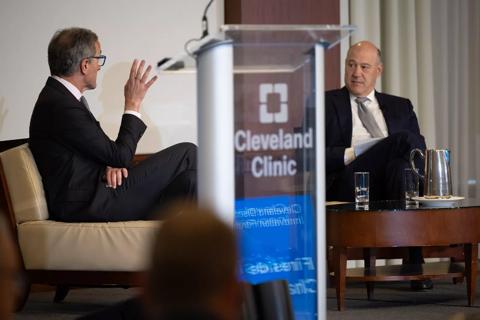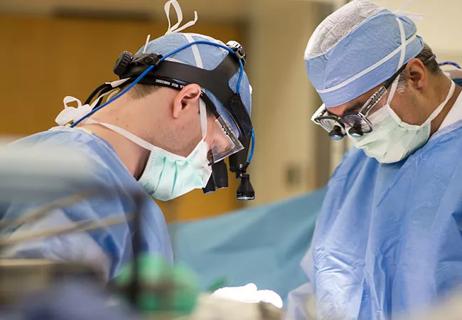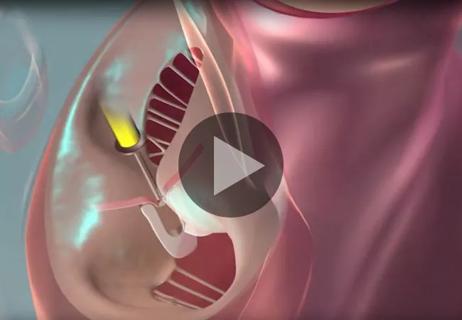A look back at Year 1 in a 21st-century hospital

It’s the first regional hospital in Northeast Ohio that Cleveland Clinic built from the ground up.
Advertisement
Cleveland Clinic is a non-profit academic medical center. Advertising on our site helps support our mission. We do not endorse non-Cleveland Clinic products or services. Policy
When Cleveland Clinic Avon Hospital opened on November 15, 2016, Cleveland Clinic CEO and President Toby Cosgrove, MD, said it incorporated “everything we’ve learned about 21st-century healthcare.” It was a paragon of Cleveland Clinic best practices, operating efficiencies and technological advances. It was a “new kind of hospital for a new era in healthcare.”
Looking back one year later, has Avon Hospital lived up to expectations? Have the best-laid plans truly produced the best outcomes?
Yes, says Rebecca Starck, MD, President of Avon Hospital. All the envisioning, planning and preparation have been worth it, she says.
“We not only built a hospital from the ground up, we built a culture,” she says. “We spent well over one year preparing for the onboarding of nearly 900 caregivers — medical staff; clinical caregivers; and administration, dietary and facilities personnel. The result has been an environment where patients not only receive exceptional care, but also feel compassion as soon as they walk in the door. All our caregivers, regardless of job description, know that each patient is their priority.”
In this Q&A, Dr. Starck reveals what worked well during Avon Hospital’s first year, as well as what they’ve learned.
What were Avon Hospital’s top achievements in its first year?
Dr. Starck: The first big achievement happened soon after we opened in mid-November 2016. Joint Commission surveyors visited us in early December. We hadn’t expected them until 2017, but they gave us an extremely positive review, and we achieved an early accreditation. The surveyors commented that for being a brand-new hospital, we functioned like a long-established, well-run operation.
Advertisement
Our patients have reported similar sentiments. According to HCAHPS surveys, Avon Hospital consistently ranks at or near the 90th percentile nationally in several domains, including likelihood of recommending the hospital.
Our employee feedback has been stellar as well, with 92 percent participation in employee surveys. Avon Hospital scores at the 86th percentile nationally for employee engagement (earning a 4.31 out of 5.00) and at the 88th percentile for high reliability (earning a 4.33 out of 5.00). This reflects our culture of safety and teamwork.
What are the biggest things Avon Hospital has had to learn?
Dr. Starck: We’ve had to get smarter about using new high-tech capabilities.
Incorporating advanced technology was a goal when developing the hospital. We recognized that technology could cost a lot financially, so we intentionally chose only the capabilities that would either improve safety and quality of care, or improve caregiver efficiency. It was important to us to be high-touch in addition to being high-tech.
Small, wearable communication devices were one technology we invested in. Each caregiver wears one so they can be contacted immediately, anywhere in the hospital, without a phone or pager. While the devices have worked well, we needed to learn how to best use them during busy shifts and minimize interruptions in direct patient care — like when a nurse would receive a patient call while in another patient’s room. We’ve had to learn how to incorporate these tools into our workflow so we respond to patients appropriately and effectively.
Advertisement
Interactive TV is another technology we’ve been excited about. Every inpatient room has one. Patients can watch educational videos, learn about their condition and treatments, and view their electronic medical record, among other things. We intended to use interactive TV to better engage patients and help them better understand their care plan. That’s worked to some extent, but we can do more to optimize this technology. There are more features that we can begin using more regularly. We continue to focus on further enhancements.
How has all the work that went into architectural and operational design affected patient and caregiver satisfaction?
Dr. Starck: Cleveland Clinic invested a great deal to research the best design of patient rooms and clinical workspaces. We built mockup rooms and invited feedback from well over 1,000 patients and caregivers.
As a result of their input, all patient rooms are private yet have high visibility. Patients value the privacy but also how spacious and comfortable the rooms are for them and their visitors. Nurses appreciate how they can see the whole patient from the hall — not just a patient’s feet — although privacy curtains can be drawn when desired.
Instead of standard nurse stations, we built interdisciplinary workstations, so nurses, physicians, physical therapists, pharmacists and other caregivers can collaborate in the same area. The result has been great efficiency, enhanced communication and an ideal team environment.
Design decisions have benefited our bottom line as well. For example, Avon Hospital was built to LEED Silver status. With large windows to harvest natural light, low-flow faucets and other environmentally friendly features, our energy usage is 17 percent lower than other regional hospitals. Also, our automated inventory management system has saved more than $380,000, just in our first year, by helping us better track, use and reorder 400,000-plus medical products.
Advertisement
What are Avon Hospital’s goals for 2018?
Dr. Starck: We will continue the growth and development of our service lines, especially building up our cardiac and pulmonary care teams, and increasing complexity of cases. We will remain focused on providing a seamless transition of care throughout the hospital and from hospital to outpatient, long-term care settings or home with follow-up appointments.
Advertisement
Advertisement

Advanced software streamlines charting, supports deeper patient connections

Cleveland Clinic and IBM leaders share insights, concerns, optimism about impacts

Cleveland Clinic will offer rapid, pinpoint airborne transport of medications and other medical items

$50 million pledge will help remove sources of lead exposure from Cleveland homes

The spine surgeon will oversee more than 125 staff physicians in his new role

Merlino rejoins Cleveland Clinic to help execute bold strategic vision

Reduces muscle pain caused by cholesterol-lowering drugs

FDA makes MitraClip available to more patients with mitral regurgitation